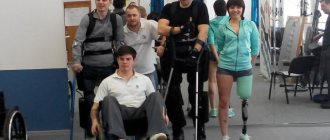Is a stroke a valid reason for disability?
Elderly citizens often face this problem, although the anomaly can also affect young people. In any case, experts divide stroke into:
- hemorrhagic, characterized by profuse bleeding of the brain, affecting most of it;
- ischemic, in which, against the background of minor hemorrhage, massive blockage of blood vessels is observed.
In both cases, a functional malfunction in the brain cannot be ruled out. For example, the following are diagnosed:
- paresis, paralysis;
- chewing dysfunction;
- decrease or loss of memory;
- deterioration in the ability to speak;
- visual abnormalities up to loss of function;
- problems with the musculoskeletal system.
One of the listed manifestations is often enough for experts to record the inability of the subject to take care of himself independently and his need for support (including from the state).
To cope with the consequences of the anomaly, exercise therapy, massage, and physiotherapy are used as rehabilitation. The more competent and quickly the health improvement measures were taken, the higher the chances of getting a light group.
Who is eligible for disability after a stroke?
The disease in question is included in the list of health problems that qualify for special status. But according to the law, in addition to diagnosis, ITU experts must observe a serious limitation of capabilities (at least one). That is, in case of successful rehabilitation, they are not sent for examination.
The question of establishing a group becomes relevant only if there is no positive result from treatment or if the prognosis is unfavorable (there is a risk of a second strike, etc.).
What needs to be done to obtain disability after a stroke
The doctor gives the patient referrals to specialists in various fields (cardiologist, ophthalmologist, psychiatrist, etc.) and for examinations (MRI, radiography, CT, ultrasound, ECG, EEG, laboratory diagnostics). The patient presents the data to the commission, and on their basis they make a decision on assigning disability status.
Disability after stroke
After all this, the commission voices either a positive or negative decision, which is formalized in the form of an act. If a citizen receives the status of “disabled,” he is given a certificate indicating the disability group and an individual rehabilitation program.
It should be noted that the main criterion for registration of disability is dysfunction. After a stroke, the most characteristic symptoms will be unilateral paresis of the limbs, loss of coordination, epileptic seizures, and mental disorders. In the absence of a functional impairment, you may be denied registration for disability; if you consider this to be illegal, you should contact the city health department or the Ministry of Health. If the answer is positive, the MSEC commission will be held again, but at a higher level.
To begin with, it should be noted that the registration of disability after a stroke does not have a significant difference with the assignment of disability in general. According to the legislation of the Russian Federation, any citizen of Russia can apply for disability if he has the criteria that define the disease, but to determine the full list of these indications, there is a special commission consisting of expert doctors.
Who is eligible for disability after a stroke?
Elimination of large physical and psycho-emotional stress. Work in conditions of sudden changes in temperature conditions is not permissible. Interaction with harmful, toxic substances and the harmful effects of vibration loads should be excluded. It is impossible to carry out labor activities with a long forced position of the body, especially the neck and head.
May 11, 2021 semeiadvo 277
Share this post
- Related Posts
- How much is the cost of living for a family of 3 people in the Republic of Bashkortostan
- Deadline for payment of personal income tax in 2021 on sick leave
- Deadline for amending the SNT charter
- Programs for large families in 2021 in the Altai Territory
Determination of disability group after stroke in 2021
During the medical and social examination (MSE), doctors, before making a decision on assigning a group, take into account a number of criteria, the degree of loss of various opportunities, and more:
| Disability group | Degree of lesions | EDSS score | Characteristics |
| Third | 40-60% | 3,0-4,5 |
|
| Second | 60-80% | 5,0-7,0 | Despite the presence of persistent impairments, the patient is able to take care of himself. Work skills are often retained. |
| First | >80% | 7,5-9,5 |
· Requires constant care from another person. |
In the process of examination, in addition to the state of health, the social component of the subject’s life, conditions, etc. are taken into account.
The legislative framework
To obtain a disability group, you must contact your attending neurologist. He issues a referral for consultation with other specialists, and it is necessary to undergo laboratory and diagnostic examinations, for which the following tests will be required:
Determination of disability group
If the commission has assigned a disability that is not permanent, then it is necessary to undergo re-examination. It is prescribed to determine the further dynamics of health, and for disabled people of group 1 - 2 times a year, and 2 and 3 - once.
- The first is the most severe and is issued to citizens with severe symptoms of the disease. For example, they move poorly and cannot speak. Experts consider such patients to be completely incompetent.
- The second one is also issued to patients with bright, but less pronounced symptoms of the disease. Despite problems with walking, spatial orientation, and speech, such patients can take care of themselves independently.
- Third , when mild functional impairments do not lead to disability, such disabled people can work under favorable working conditions.
- Can an individual take care of himself: is he able to go to the toilet on his own, prepare food for himself, clean up after himself;
- Is a person dependent on the people around him?
- How does the patient navigate in space?
- How appropriate is a person’s behavior?
You might be interested ==> Certificate for the purchase of residential premises for the Chernobyl liquidators 2021
Registration process
There are times when a patient is not given a category. If this happens, he can re-submit an application to the medical and social bureau within 3 days. Within 1 month, specialists re-examine the patient’s case and make a new decision.
In order to undergo a medical and social expert commission, the patient must have with him all the certificates and documents that can confirm the impairment of neurological functions and disability. Experts must provide:
Prohibition on certain types of work activities
The right to work remains despite the special status, although the recipient must work taking into account his capabilities and medical recommendations. After a stroke, it is usually advised to avoid:
— harmful working conditions;
— psychological stress;
- standing on your feet for a long time;
— low temperatures for many hours;
In general, before employment, a worker with a disability should assess all risks to avoid recurrent stroke.
Basic benefits when receiving disability
A special status caused by a stroke provides benefits and cash payments. The amount of assistance provided is similar to what is guaranteed to other citizens with disabilities:
| Types of benefits | Examples |
| Financial | 1. Payment of benefits according to the established group. 2. EDV. 3. Additional payments depending on various conditions: regional, for dependents or up to the subsistence level. |
| Tax | A discount on tax payments or their complete cancellation. |
| Housing | 1. Providing real estate for ownership or lease. 2. Subsidizing payment for housing and communal services. 3. Compensation for 50% of the amount spent on utility bills. |
| Social | 1. Free travel on public transport. 2. Job quotas. 3. Discount on purchasing train tickets. 4. Admission to a university under special conditions. |
| Medical | 1. Extraordinary care in hospitals. 2. Issuing prescription medications free of charge. 3. Free trip to the sanatorium. |
If the problem has caused paralysis, visual, auditory or other anomalies, the necessary devices (hearing aid, cane, etc.) are provided to compensate for lost capabilities. But special TSRs specifically for stroke patients are not provided.
What must be done to obtain disability?
Strokes are characterized by a variety of causes that cause the disease. It has been proven that the etiology of stroke in women and men differs in some cases. The causes of stroke in women mainly lie in the pathophysiology of the fertile period and menopause; in men, they are associated with occupational risks and bad habits. Associated with these same features.
How to get a disability pension and everything for IPR?
Pine cones are a source of beneficial substances that help with various diseases. Thus, phytoncides strengthen the immune system and have an antimicrobial effect. Essential oils give products made from fir cones a pleasant pine aroma. Tannins can stop the death of brain cells. Therefore, pine cones are useful in treating and.
If the medical and social commission recognizes that the person who suffered a stroke has fully recovered and can return to normal work activities, the disability is removed. All payments are stopped. If there are no improvements within 4 years, the disability group is assigned for life.
- Contact your clinic. Tell your therapist about your desire to get disability after a stroke and your current symptoms.
- Upon special referral from a doctor, undergo examination by an endocrinologist, cardiologist, otolaryngologist, or psychiatrist.
- Donate blood, urine for tests, take an X-ray of the skull, Doppler ultrasound, ECG, MRI/CT, ultrasound of blood vessels. The therapist may also prescribe some additional studies according to the patient’s individual indications.
- Come with all the data and a referral from a therapist to undergo a Medical and Social Examination. Have your passport with you.
- Write a statement about your desire to apply for disability.
- Pass a personal examination by the ITU commission. Members of the commission need to talk in detail and without embarrassment about all existing health problems. This data will be taken into account when making a decision.
You might be interested ==> Udo amendments for 228.1
When can you start filing for disability?
Stroke is one of the most complex diseases of the central nervous system, which in 75–80% of cases ends in disability of the patient. Citizens of the Russian Federation who are faced with this problem have the right to be assigned the appropriate disability group and receive financial assistance from the state.
A medical commission can be conducted in absentia based on the documents provided, and in addition, by referral or written consent from the attending physician. In the relevant direction there must be a note indicating permission to carry out this event at home.
It is extremely important that disabled people of the first disability group after a stroke undergo re-examination once every couple of years. Patients of the second and third groups, as already noted, should do this every year. This is, first of all, necessary so that the medical commission has the opportunity to monitor any deterioration or improvement in the health status of citizens. Thus, depending on the results of a newly conducted medical examination, disability may be extended or its relevance revised.
What is the basis for recognizing a patient as disabled?
Not all patients can apply for disability. To obtain it, medical indications are required. Disability is assigned in accordance with Federal Law based on the results of all examinations completed. As a rule, it is assigned to those patients whose brain has not fully recovered, and in addition, to those who have impaired movement, speech and other functions.
A victim with pronounced dysfunction of the motor system and paralysis of the limbs is assigned disability of groups I - II, depending on how much the person needs outside help when performing everyday tasks.
Registration of disability for a bedridden patient after a stroke is formalized in accordance with existing legislative norms. Since the patient is not able to move independently, an official representative should be appointed to issue certificates and contact the ITU.
List of documents for registration of disability
Registration of disability after a stroke must begin with the collection of all necessary documents. One of the main reasons for ITU's refusal to appoint a group is the incomplete list of collected documentation. In this regard, one rule applies: the more detailed the medical history and the list of all tests performed, the more likely the commission’s favorable decision.
- Impaired coordination of movements;
- Significant decrease or complete loss of vision in one or both eyes;
- Disorders of the musculoskeletal system;
- difficulty chewing or swallowing;
- Numbness, weakness, tremor of the limbs;
- Changes in the speech apparatus;
- Memory impairment;
- Changes in consciousness;
- Impaired perception of reality;
- Decreased mental abilities.
If these violations are present, the patient can count on receiving the appropriate status. The group will depend on how severe the disease is and the degree of decline in body functions.
You might be interested ==> Will preschool teachers in Buryatia receive a salary increase in 2021?
Disability after stroke
- The third group is considered the easiest. It is given if problems in the body’s functioning are not irreversible. A patient with group 3 can recover completely over time with proper treatment and rehabilitation programs. In group 3, you can lead a lifestyle close to what is usual for healthy people with the help of supportive therapy or special medical devices. It is permissible to work under this status if there are special lightweight conditions;
- The second group is given when disturbances in body functions are severe. A person is unable to adequately perceive reality or move fully. Most often, these people have the opportunity to care for themselves with a little outside help or with the use of special medical structures. Labor activity with such disorders is contraindicated;
- The first group is the most difficult. Disturbances in the body reach a stage when a person becomes helpless even in basic everyday matters. To perform the simplest daily actions, he needs the help of strangers. Labor activity in this embodiment is not only contraindicated, but also impossible.
When examining a patient, the commission may refuse to grant him a disability. In this case, if the patient does not agree with the conclusions of the commission, he, in accordance with the law, within a month has the right:
The severity of neurological symptoms depends on the severity of the stroke. You can register for disability after a stroke not immediately, but after some time, that is, 8-12 months after the end of the recovery period.
Hemorrhagic stroke
If the patient was hospitalized, the attending physician makes an extract and prepares a referral. At the request of relatives, experts go to the home to examine the bedridden patient. The patient's authorized representative provides the commission with documents confirming his identity and work record.
According to the norms of the current Russian legislation, which are based on Federal laws and legislative documents of the constituent entities of the Russian Federation, all patients without exception have the right to register disability, subject to the presence of appropriate medical indications.
Registration process
First of all, the attending physician or social security representative must refer the patient to a medical examination. Only the officially recorded diagnosis is considered, medical records are taken into account. maps and present lesions.
You can apply for the group after your condition has stabilized, that is, when at least 4 months have passed since the impact. If there are grounds for assigning a disability, the doctor first sends you for tests and examinations and only after that sends you to an ITU.
List of documents
According to the law, a potential beneficiary presents to the ITU Bureau:
— your SNILS and passport;
— application form 088/у-06;
— extracts from the medical history;
- referral for examination.
A reference from the place of work is attached if the person being examined was employed before the illness.
Where to contact
With the prepared documents on a specific day, you should appear for a commission at the ITU bureau (by registration or by type of illness - there may be such departments in the regions).
Refusal to provide a certificate of disability
The inspection procedure involves assessing:
— general condition;
— degree of deterioration of capabilities;
— the impact of the problem on the quality of life.
After the inspection, questioning, and study of documents, the commission members deliberate, vote and notify the examinee of their decision. The status may not be assigned when:
— criteria have not been identified that would allow establishing even the easiest group 3;
- the documents are fake (here it can even lead to a criminal case).
How to appeal an ITU decision
If a negative decision is regarded as violating the rights of the beneficiary, you can appeal the ITU result step by step. To do this you should:
- seek new direction;
— provide a package of papers to a higher bureau;
— repeat the health assessment procedure.
If you refuse again, you can go to court. Additionally, the involvement of an independent expert is allowed.
Procedure for processing documents
Disability is assigned, but a person’s health status after a stroke can change, both for improvement and for deterioration. To confirm the status of a disabled person, it is necessary to undergo re-examination:
Regular status confirmation
It is important to know a detailed algorithm of actions on how to obtain disability after a stroke. To contact the medical and social examination authorities, you must have a referral from your attending physician and collect a package of documents established by law.
You may be interested in:: Benefits for military veterans in the Kursk region in 2021
Compliance with the procedure for registering disability does not guarantee a 100% positive decision from the ITU. The commission may decide that the condition of the applicant is satisfactory. He is able to work and provide for himself. In this case, assignment of a disability group will be denied.
- therapeutic and rehabilitation measures: taking special medications, physiotherapy and reflexology, exercise therapy, therapeutic massage;
- Spa treatment;
- social assistance: training in basic self-care skills, and, if indicated, professional retraining;
- psychological assistance from specialized psychologists to prevent depression and improve the social adaptation of a disabled person;
Can disability be lifted after a stroke?
It is important for patients to understand that not all of them have the right to register for disability after a stroke under the legislation of the Russian Federation. The issue is regulated by Federal Law of the Russian Federation No. 181 “On Social Protection of Disabled Persons”. It indicates which physical and mental health indicators qualify the patient for disability assistance.
Remember: the conclusions received from doctors must be certified by the chief physician of the hospital. They must also bear the seal of the given medical institution. After this, the date and time of the person’s examination is determined.
According to the legislation of the Russian Federation, disabled people of all groups must regularly undergo repeated medical examinations. For groups III and II - annually. At I - every 2 years. If this is not done, the disability will be automatically removed.
When is it issued?
Remember: re-examination is carried out when the patient receives a group that is not included in the indefinite category. This is how specialists monitor his health and changes. Re-examination of patients in the first group is carried out 2 times a year, 2 and 3 groups – once a year.
In the case of registering a group for a pensioner and subsequently receiving social benefits, the entire process described above undergoes some changes. You need to start by contacting the local Pension Fund with a certificate from the ITU. There, your situation will be reviewed, which will allow you to receive the appropriate certificate, as well as a small pension supplement. What is most interesting is that no one forbids a pensioner to work. The fact of employment in this situation will in no way affect either the amount of social benefits or the establishment of a group.
As a result of a stroke, a disability group is established based on the considerations that there has been a violation of the basic functions of the brain, which are involved in solving everyday, basic tasks necessary to maintain life and self-care.
Registration of the 3rd group
In this case, an IPR is drawn up - an individual rehabilitation program. The next step is for a person to contact the social security authorities and the pension fund in order to receive material and social support for a certain period. Please note that those people who have received a disability group due to a stroke undergo re-examination, since as a result of the ongoing rehabilitation it is possible not only to improve their general condition, but also to return to their ability to work. After all, the brain is unique in that some of its parts can take over (partially) the functions of other functional areas.
If the patient does not agree with the conclusions of the commission (if the status of a disabled person is denied or there are disagreements regarding the assigned group), he has the right to file a protest with the ITU Main Bureau for re-examination of the documents. In case of refusal, file a claim in court to appeal the decision of the ITU Bureau.
If the patient cannot be in the ITU office due to restrictions in movement or as a result of impaired cognitive functions, the examination is carried out at the place of residence or after hospitalization in a hospital.
Establishing disability after a stroke in a bedridden patient
Regeneration of damaged areas of the brain occurs individually for each patient. This depends on the type and severity of stroke, concomitant diseases (hypertension, atherosclerosis, diabetes), timely initiation of adequate therapy and the quality of rehabilitation treatment.
You may be interested in:: Veterans of labor of the Ulyanovsk region will there be an increase in wages in 2021
If, after passing the disability group, the patient is refused, within 3 working days he can submit a written application to the ITU bureau. After the first month, the patient will be examined again and a report will be issued.
- restorative therapies (physical therapy, massage, therapeutic exercises, physiotherapy, reflexology);
- necessary medications (Vinpocetine, Glycine);
- Spa treatment;
- training in household skills for self-care;
- training in possible professions (depending on the disability);
- psychological rehabilitation “Overcoming” (consultations with psychologists).
Terms of re-examination
- can the patient take care of himself (go to the toilet, cook food, clean up after himself);
- how dependent the patient is on others;
- orientation and coordination in space;
- adequacy of behavior.
The commission also takes into account whether the patient has previously suffered strokes and whether he has a history of:
- Make an appointment with a therapist at a clinic near your place of residence. Talk about existing symptoms and impairments, report your intention to become disabled.
- Be examined by a physician and referred by several specialists. As a rule, this is a cardiologist, neurologist, psychiatrist, endocrinologist, otolaryngologist.
- Undergo hardware examinations (ultrasound, ECG, cardiac cardiogram, MRI, etc.) and pass the necessary tests (blood/urine).
- With the results of these studies, visit the Medical and Social Expertise. Appearance is required with a passport.
- Complete an application for a disability group.
- Be examined directly by specialists who are members of the medical and social commission. They also need to be told directly about the existing dysfunctions of the body, the presence of difficulties in caring for themselves in everyday life. This information influences the authority's decision.
Peculiarities of assigning disability in non-standard cases
Since after a stroke the consequences can be very unpredictable, various nuances are taken into account when establishing disability. Let's take a closer look at them.
Pensioners
Preferential status in this case is formalized in the same way as when examining other patients. That is, the requirements are similar to those described above. The only significant difference is the ability to immediately receive a group for life. In any case, after being assigned a disability, the pensioner must additionally contact the Pension Fund to recalculate the pension.
Unemployed
The health of citizens who do not have a permanent place of work is assessed by specialists according to standard criteria for all. It’s even a little easier for the unemployed, since they don’t have to wait 4 months and apply for sick leave like employed people. But without work experience, you are only entitled to a social disability pension.
Bedridden patients
In difficult situations, when a potential beneficiary is not able to visit the ITU office, there are several options:
— carry out a health check at home or in a hospital;
— make a decision based on the medical history and other documents without the patient’s personal presence.
Registration of a disability group after ischemic stroke
This group is intended for stroke survivors whose health has been affected, but not as significantly as in the case of the first two groups. In people from the third group, dysfunctions are also persistent, but are characterized by moderate severity.
Such a person can even continue to perform his work duties, but the working conditions, according to the current legislation, are somewhat easier for him. Some types of work are completely prohibited (driving a car, work requiring increased concentration, etc.).
Let's consider several special cases of disability after a stroke.
The procedure for obtaining disability for a pensioner is practically no different from how this status is assigned to an employed citizen. The only difference is that the package of documents for the commission includes a pension certificate and documents confirming the amount of the pension received. The disability benefit will be calculated not based on the amount of labor remuneration, but with a focus on the amount of the person’s pension payments.
A special feature of disability registration in this case is the victim’s inability to move. Accordingly, such a patient requires a proxy who carries out all actions of a bureaucratic nature (going to authorities, collecting documents, etc.) on his behalf. The right of such a person to act in the interests of a bedridden patient is confirmed by a notary.
However, the authorized representative still cannot undergo examination for the patient. Therefore, in the event of a complete restriction of a person’s movement, there are two options for action:
- Calling specialists to your home (which happens most often);
- Delivery of the patient to the hospital using special equipment and special transport.
The peculiarity of assigning disability to an unemployed person who has suffered a stroke is that such a person must register with the Center for Labor Protection (if he was not previously registered there). The difficulty lies in determining the amount of disability benefits, because the person did not receive a salary, therefore, calculating its amount is problematic.
It matters how long a person remained unemployed. It’s one story if he lost his job as a result of an accident and disability, and a completely different story if the person, in principle, was not officially employed for a long period of time.
Groups are established in accordance with the patient’s condition from the “lightest” (group III) to the most severe (I).
The third group of disability after a stroke is given to persons with persistent—observed for 3–4 or more months—functional impairments of moderate severity. The patient can move independently. There are minor disturbances in speech, spatial orientation, and mental reactions, but these functions are not completely lost. Existing health problems do not prevent the patient from performing simple work. At the same time, there are restrictions on certain types of activities: you cannot drive a car, work with equipment that requires high concentration, etc.
The first is assigned to persons with the most severe functional impairments. Usually these are patients who cannot move independently and take care of themselves at home, and have serious mental, speech and other disabilities. They require round-the-clock supervision and assistance in everything. This group also includes bedridden patients and patients in a vegetative state.
Now the legislation of the Russian Federation has adopted such a concept as “disability insurance pension”. It is assigned to persons who have at least a day of insurance coverage. This includes time devoted to work, caring for a child or a pensioner over 80, and other cases provided for by law.
For middle-aged and elderly people who have suffered a stroke, the following are strictly contraindicated:
- heavy physical activity;
- high physical activity;
- stress;
- sudden changes in temperature;
- contact with toxic substances;
- vibration loads;
- working in a position in which the head or body is tilted for a long time.
When choosing a place of work, you need to take into account all these recommendations, as well as the individual characteristics of the patient’s condition.
After a stroke, an employed patient receives sick leave for 4 months. After this period, you can apply to the Medical Forensic Examination (MFE) to obtain disability.
An unemployed citizen can begin the process immediately after discharge. Even if he contacts the ITU 2 or 3 months after the stroke, he will not be denied an examination.
Re-examination
If the disability is not permanent and requires periodic confirmation of the group, the beneficiary is required to undergo another examination before the certificate expires. In addition, the condition assessment process may be caused by deterioration in performance.
Be that as it may, the criteria established by law are always considered and taken into account. And if you miss the moment when the certificate expires, your pension and benefits will be cancelled.
| Disability group | Validity period of the certificate |
| First, second | 2 years |
| Third | 1 year |
By the way, if your health deteriorates significantly, you can even reconsider the indefinite group.








